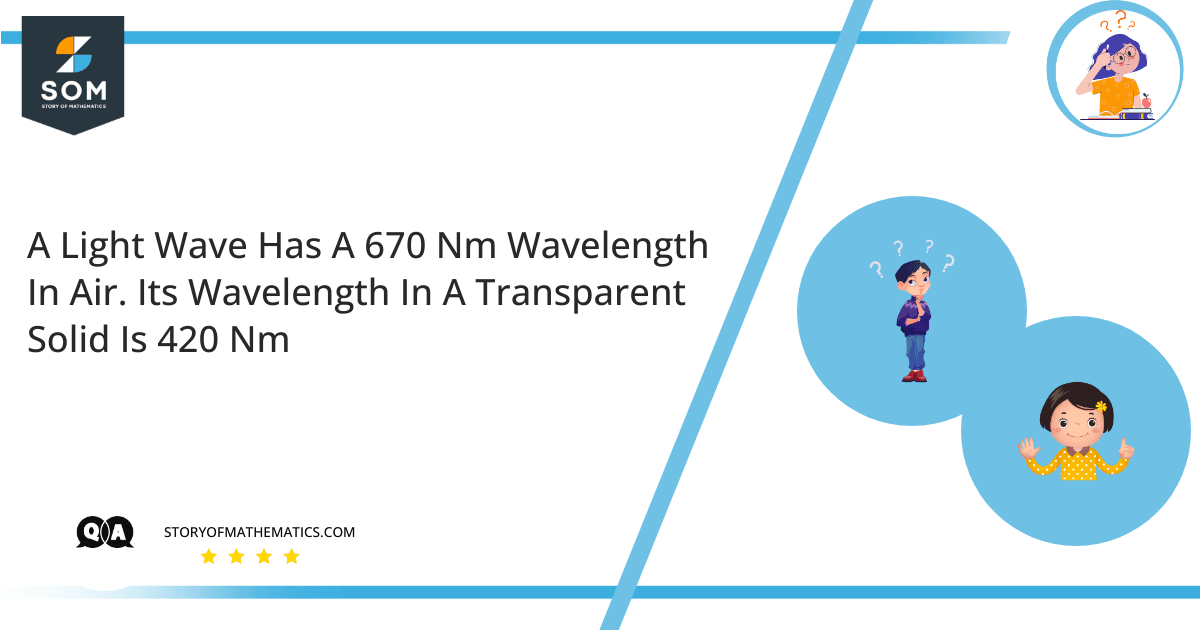
This question aims to study the effect of material on the wave speed when it travels from one material to another.
Whenever a wave strikes the surface of another material, a part of it is bounced back into the previous medium (called reflection phenomenon) and a part of it enters into the new medium (called refraction phenomenon). During the refraction process, the frequency of the light waves remains the same, however the speed and wavelength change.
The relationship between the speed (v), wavelength ($ \lambda $) and the frequency f of a wave are given by the following mathematical formula:
\[ f_{ solid } \ = \ \dfrac{ v_{ solid } }{ \lambda_{ solid } } \]
Expert Answer
Given:
\[ \lambda_{ air } \ = \ 670 \ nm \ = \ 6.7 \times 10^{ -7 } \ m \]
\[ \lambda_{ solid } \ = \ 420 \ nm \ = \ 4.2 \times 10^{ -7 } \ m \]
Let’s assume that:
\[ \text{ Speed of Light in Air } \approx v_{ air } \ = \ \text{ Speed of Light in Vacuum } = \ c \ = 3 \times 10^8 m/s \]
Part(a) – Calculating the frequency of the light waves in the given solid:
\[ f_{ air } \ = \ \dfrac{ v_{ air } }{ \lambda_{ air } } \]
\[ \Rightarrow f_{ air } \ = \ \dfrac{ 3 \times 10^8 m/s }{ 6.7 \times 10^{ -7 } \ m } \ = \ 4.478 \times 10^{ 14 } \ Hz \]
During the refraction process, the frequency remains constant, so:
\[ f_{ solid } \ = \ f_{ air } \ = \ 4.478 \times 10^{ 14 } \ Hz \]
Part(b) – Calculating the speed of the light waves in the given solid:
\[ f_{ solid } \ = \ \dfrac{ v_{ solid } }{ \lambda_{ solid } } \]
\[ \Rightarrow v_{ solid } \ = \ f_{ solid } \ \lambda_{ solid } \]
\[ \Rightarrow v_{ solid } \ = \ ( 4.478 \times 10^{ 14 } \ Hz )( 4.2 \times 10^{ -7 } \ m \]
\[ \Rightarrow v_{ solid } \ = \ 1.88 \times 10^8 m/s \]
Numerical Result
\[ f_{ solid } \ = \ 4.478 \times 10^{ 14 } \ Hz \]
\[ v_{ solid } \ = \ 1.88 \times 10^8 m/s \]
Example
For the same conditions given in the above question, calculate the speed and frequency for a solid in which the wavelength of the light waves reduces to 100 nm.
Given:
\[ \lambda_{ air } \ = \ 670 \ nm \ = \ 6.7 \times 10^{ -7 } \ m \]
\[ \lambda_{ solid } \ = \ 1 \ nm \ = \ 1 \times 10^{ -7 } \ m \]
Using the same assumption:
\[ \text{ Speed of Light in Air } \approx v_{ air } \ = \ \text{ Speed of Light in Vacuum } = \ c \ = 3 \times 10^8 m/s \]
Calculating the frequency of the light waves in the given solid:
\[ f_{ solid } \ = \ f_{ air } \ = \ \dfrac{ v_{ air } }{ \lambda_{ air } } \]
\[ \Rightarrow f_{ solid } \ = \ \dfrac{ 3 \times 10^8 m/s }{ 6.7 \times 10^{ -7 } \ m } \ = \ 4.478 \times 10^{ 14 } \ Hz \]
Calculating the speed of the light waves in the given solid:
\[ v_{ solid } \ = \ f_{ solid } \ \lambda_{ solid } \]
\[ \Rightarrow v_{ solid } \ = \ ( 4.478 \times 10^{ 14 } \ Hz )( 1 \times 10^{ -7 } \ m ) \ = \ 4.478 \times 10^7 m/s \]
